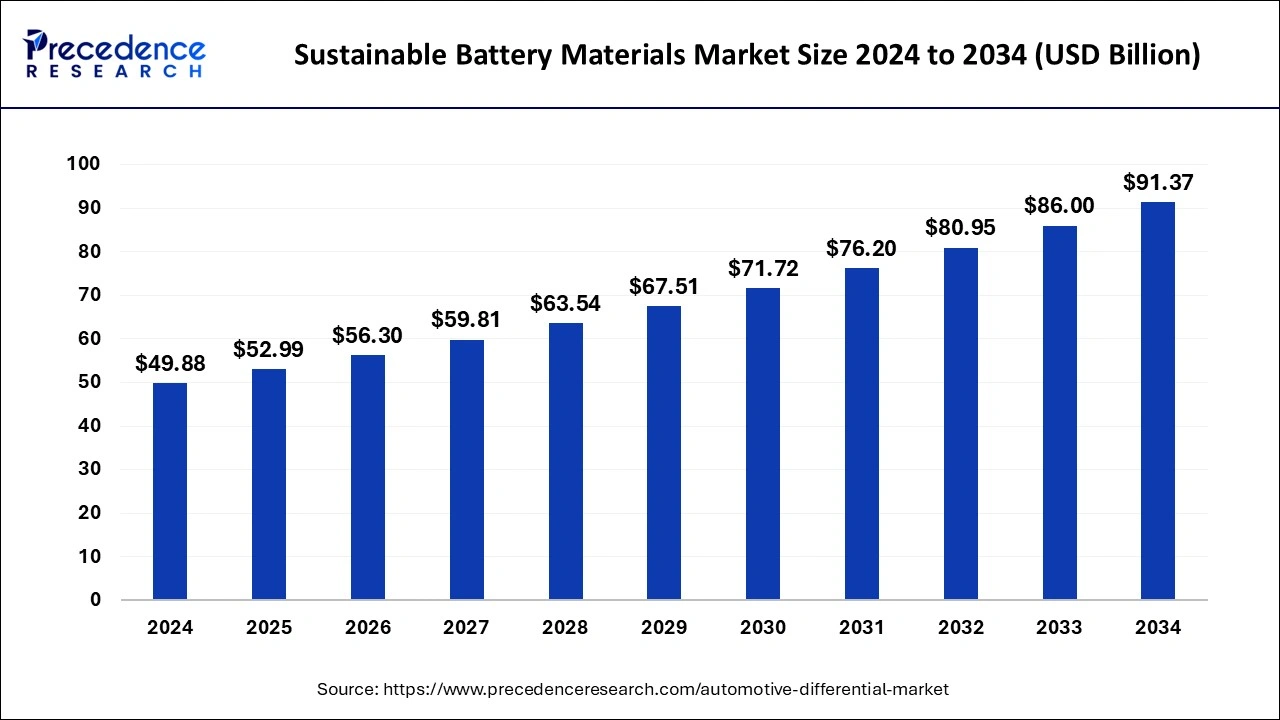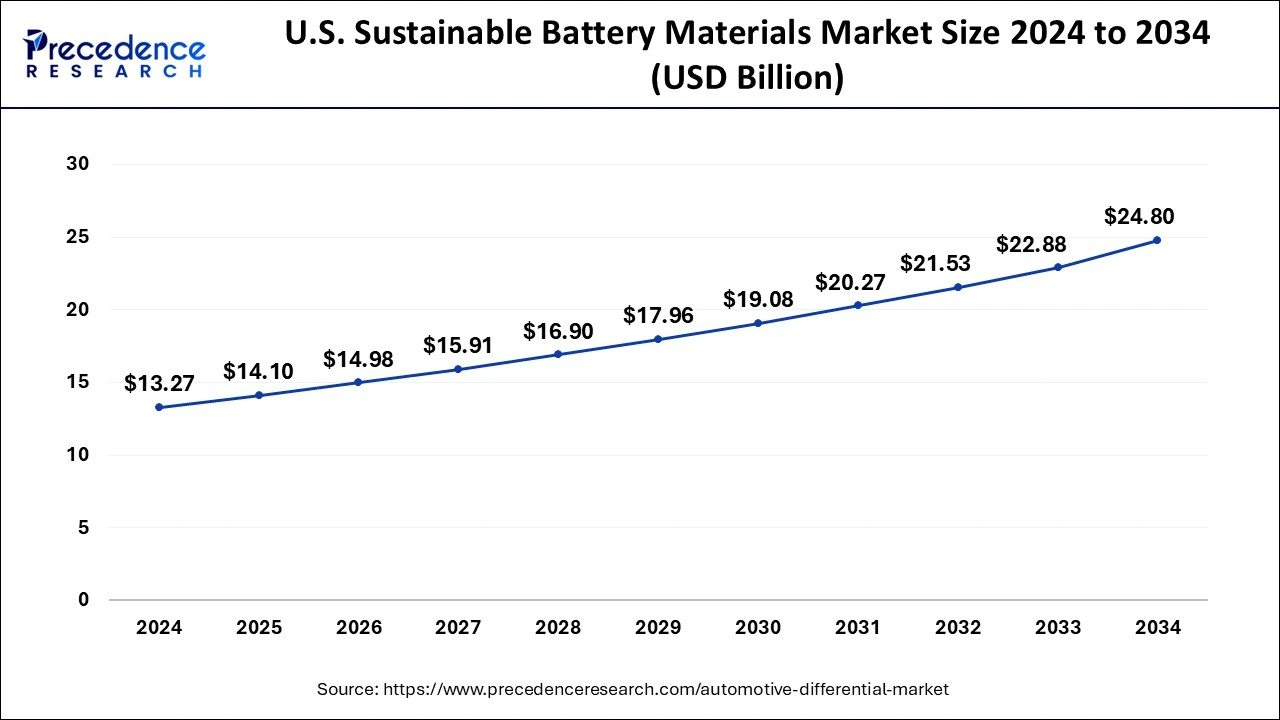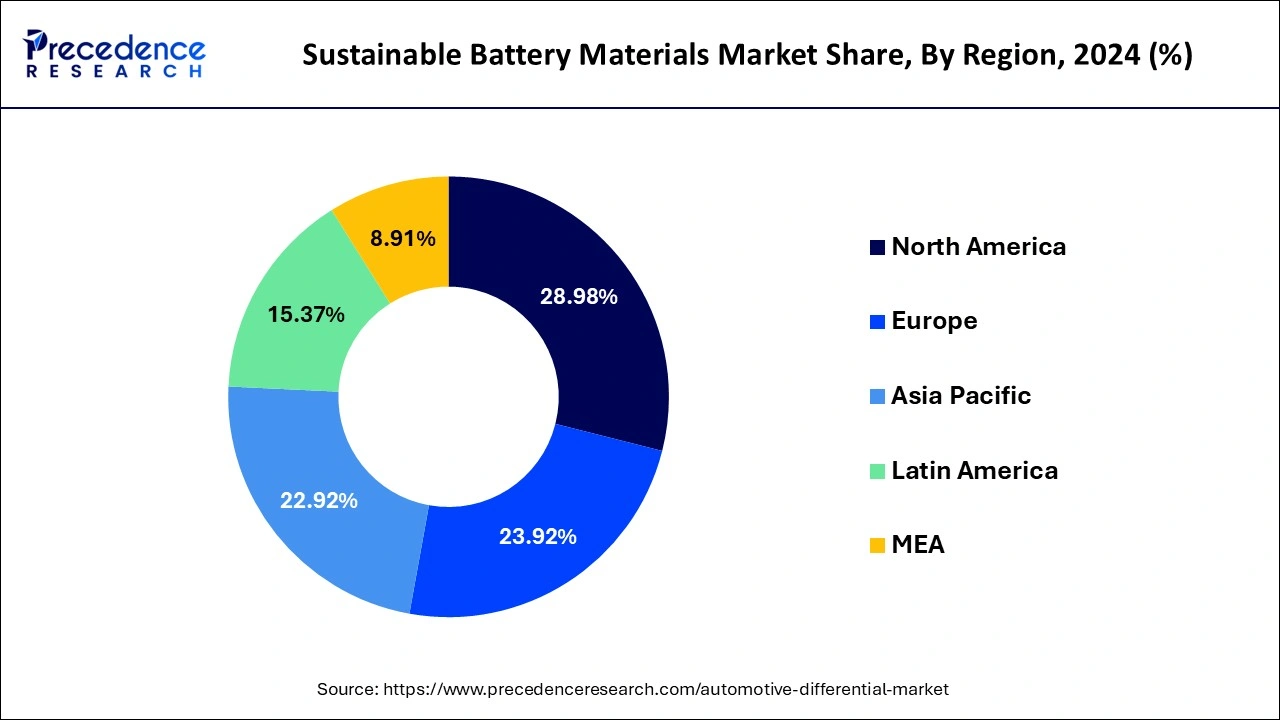List of Contents
Sustainable Battery Materials Market Size and Forecast 2025 to 2034
The global sustainable battery materials market size was accounted for USD 49.88 billion in 2024 and is anticipated to reach around USD 91.37 billion by 2034, growing at a CAGR of 6.24% from 2025 to 2034. The rising demand for clean battery materials, surging investments in developing sustainable battery materials and the increased global impact of conventional energy sources on health and environment are driving the growth of the sustainable battery materials market.

Sustainable Battery Materials Market Key Takeaways
- North America dominated the global market with the largest market share of 28.98% in 2024.
- Asia Pacific is projected to expand at the notable CAGR during the forecast period.
- By Battery Type, the lithium-ion segment contributed the highest market share in 2024.
- By Battery Type, the lead acid segments is estimated to be the fastest-growing segment during the forecast period.
- By Material, the cathode segment captured the biggest market share in 2024.
- By Material, the anode segment is expected to grow at a significant CAGR from 2025 to 2034.
- By Application, the consumer segment has held the largest market share in 2024.
- By Application, the automotive segments is predicted to be the fastest-growing segment during the forecast period.
Benefits of Artificial Intelligence in Battery Materials
AI integration in development of sustainable battery materials has sped up the process of identifying potential novel materials, in extending the battery life, for discovering new electrolytes, in better grid integration of energy sources and also in accelerating the research process thereby contributing in improved sustainability with reduced manufacturing costs and energy wastage.
For instance, in January 2024, Microsoft in collaboration with the U.S. Department of Energy's (DOE) Pacific Northwest National Laboratory (PNNL) announced the discovery of a solid-state electrolyte named N2116 which could reduce the use of lithium by up to 70%. The discovery was made using Microsoft's Azure Quantum Elements which combined AI and traditional high-performance computing (HPC) for analyzing over 32 million potential inorganic materials in less than nine months.
U.S. Sustainable Battery Materials Market Size and Growth 2025 to 2034
The U.S. sustainable battery materials market size was evaluated at USD 13.27 billion in 2024 and is predicted to be worth around USD 24.80 billion by 2034, rising at a CAGR of 6.45% from 2025 to 2034.

Asia-Pacific dominated the sustainable battery materials market in 2024. The regional growth is predicted to be aided by rapid urbanization and rising consumer spending on electric vehicles.

North America is expected to develop at the fastest rate during the forecast period. This is due to the fast adoption of electric vehicles in this region as well as increased consumer electronics purchases. The government is supporting investors in the renewable and electric vehicle industries, which is driving demand for battery-based energy storage systems, particularly lithium-ion batteries, which will help the region to flourish.
Sustainable Battery Materials Market Growth Factors
- Rising demand for sustainable energy sources.
- Various initiatives and regulations imposed by the governments for promoting the adoption of sustainable energy sources.
- The integration of renewable energy sources into power grids with the use of battery storage materials.
- Rising health concerns due to the increased greenhouse gas emissions and climate changes across the globe.
- Rechargeable batteries with higher efficiency and compact sizes is transforming their applications for daily usage.
- Advancements in manufacturing and designing of innovative sustainable battery materials leading to improved efficiency and reduced costs.
- Rising disposable incomes increasing consumer demand for electronics equipped sustainable battery materials.
- Adoption of smart energy conserving technologies in various settings such as homes, hospitals and offices.
Market Scope
| Report Coverage | Details |
| Market Size in 2025 | USD 52.99 Billion |
| Market Size by 2034 | USD 91.37 Billion |
| Market Growth Rate from 2025 to 2034 | CAGR of 6.24% |
| Largest Market | Asia Pacific |
| Base Year | 2024 |
| Forecast Period | 2025 to 2034 |
| Segments Covered | Battery Type, Material, Application, Geography |
| Regions Covered | North America, Europe, Asia-Pacific, Latin America and Middle East & Africa |
Market Dynamics
Driver
Surging Investments in Recycling and Development of Sustainable Battery Materials
The initiatives taken by various industries for recycling and development of sustainable battery materials with increasing investments and fundings is driving the market growth. Furthermore, the advancements in manufacturing capabilities with streamlined workflows and supply distributions is aiding industries in reduced production costs and minimizing energy wastage.
Restraint
Higher Investment and Development Costs
The requirement of huge investments for initiation, development, sourcing and supply chain distributions for sustainable battery materials can be major restraint hindering the growth as these production facilities need to meet the stringent carbon footprint and emission satndards.
Opportunity
Rising Government Support Towards Climate-Neutral Technologies
The increased awareness and government support for promoting various initiatives and stringent regulations for development for sustainable energy sources for reducing environmental impact and increasing resource efficiency.
- For instance, the European Union's (EU) climate strategy for battling climate change and environmental degradation with the initiative of The European Green Deal which has adopted policies to reduced greenhouse gas emissions by at least 55% by 2023 in Europe with the adoption of sustainable battery development program.
Battery Type Insights
The lithium-ion segment dominated the sustainable battery materials market share in 2024. Due to its color memory effect, high energy density, and low self discharge, it is employed in portable electronic devices. It's used in a variety of industries including consumer electronics, industrial, and automotive.
The lead acid segment, on the other hand, is predicted to develop at the quickest rate in the future years. The global demand for lead acid batteries is increasing as a result of its qualities such as ease of purchase, reliability, abuse tolerance, overcharging tolerance, and the capacity to deliver high currents.
Material Insights
The cathode segment dominated the sustainable battery materials market share in 2024. The cobalt, nickel, and manganese are the most active elements in cathode materials. Nickel, primarily lithium nickel manganese oxide and nickel cobalt aluminum oxide, is now used to partially replace cobalt.
The anode segment, on the other hand, is predicted to develop at the quickest rate in the future years. The conventional current enters a polarized electrical device through an anode, which is an electrode.
Application Insights
The consumer electronics segment dominated the sustainable battery materials market share in 2024. The growing use of lithium-ion batteries in consumer gadgets is expected to boost total sustainable battery materials industry growth.
The automotive segment, on the other hand, is predicted to develop at the quickest rate in the future years. The sustainable battery materials market is being driven by a boom in global automotive sales and production, which has resulted in a rise in vehicle electrification.
Sustainable Battery Materials Market Companies
- BASF SE
- TCI Chemicals Pvt. Ltd
- Mitsubishi Chemical Holdings
- TORAY INDUSTRIES INC.
- Kureha Corporation
- Umicore Cobalt & Specialty Materials
- NEI Corporation
- NICHIA Corporation
- Hitachi Chemical Co. Ltd
- Asahi Kasei
Latest Announcements
- In January 2025, Altilium, a UK-based clean technology leader in sustainable lithium-ion battery materials announced a $5 million strategic investment from the leading Japanese trading and investment group Marubeni Corporation, in its Series B funding round. Kamran Mahdavi, CEO of Altilium said that, “We are proud to welcome Marubeni as a strategic partner at this pivotal stage in Altilium's growth journey. Their investment strengthens our position as leaders in sustainable battery materials and reinforce our commitment to building the UK's largest EV battery recycling facility. Together, we are advancing our mission to create a UK closed-loop supply chain, reduce dependency on imported materials and lowering the environmental footprint of battery production.”
- In December 2024, Alus, a leading Korean aluminum specialist signed a Letter of Intent (LOI) with U.S. based lithium-ion battery recycling company Blue Whale Materials (BWM). Jong Wook Jeong, CEO of Alus, enthusiastically said that, “Through our partnership with Blue Whale Materials, we aim to solidify our presence in the U.S. market, expand our aluminum business, and play a pivotal role in the global battery industry ecosystem. Additionally, we plan to strengthen cooperation with Oklahoma to build a foundation for sustainable growth.”
Recent Developments
- In December 2024, Ascend Elements, a leader in sustainable battery material solutions promulgated the launch of a new lithium recovery line in 2025 at its Covington, Georgia facility. This new line will produce over 99% pure lithium carbonate recovered form used lithium-ion batteries.
- In October 2024, the Japanese technology company Asahi Kasei, a global leader in advanced materials declared the successful development of a groundbreaking electrolyte based on acetonitrile which significantly enhances lithium-ion batteries performance. The paper was presented at the Battery Show which is a leading B2B platform for battery technology professionals.
Segments Covered in the Report
By Battery Type
- Lithium Ion
- Lead Acid
- Others
By Material
- Cathode
- Anode
- Electrolyte
- Separator
- Others
By Application
- Consumer Electronics
- Automotive
- Industrial
- Others
By Geography
- North America
- U.S.
- Canada
- Europe
- U.K.
- Germany
- France
- Asia-Pacific
- China
- India
- Japan
- South Korea
- Malaysia
- Philippines
- Latin America
- Brazil
- Rest of Latin America
- Middle East & Africa (MEA)
- GCC
- North Africa
- South Africa
- Rest of the Middle East & Africa
For inquiries regarding discounts, bulk purchases, or customization requests, please contact us at sales@precedenceresearch.com
Frequently Asked Questions
Ask For Sample
No cookie-cutter, only authentic analysis – take the 1st step to become a Precedence Research client